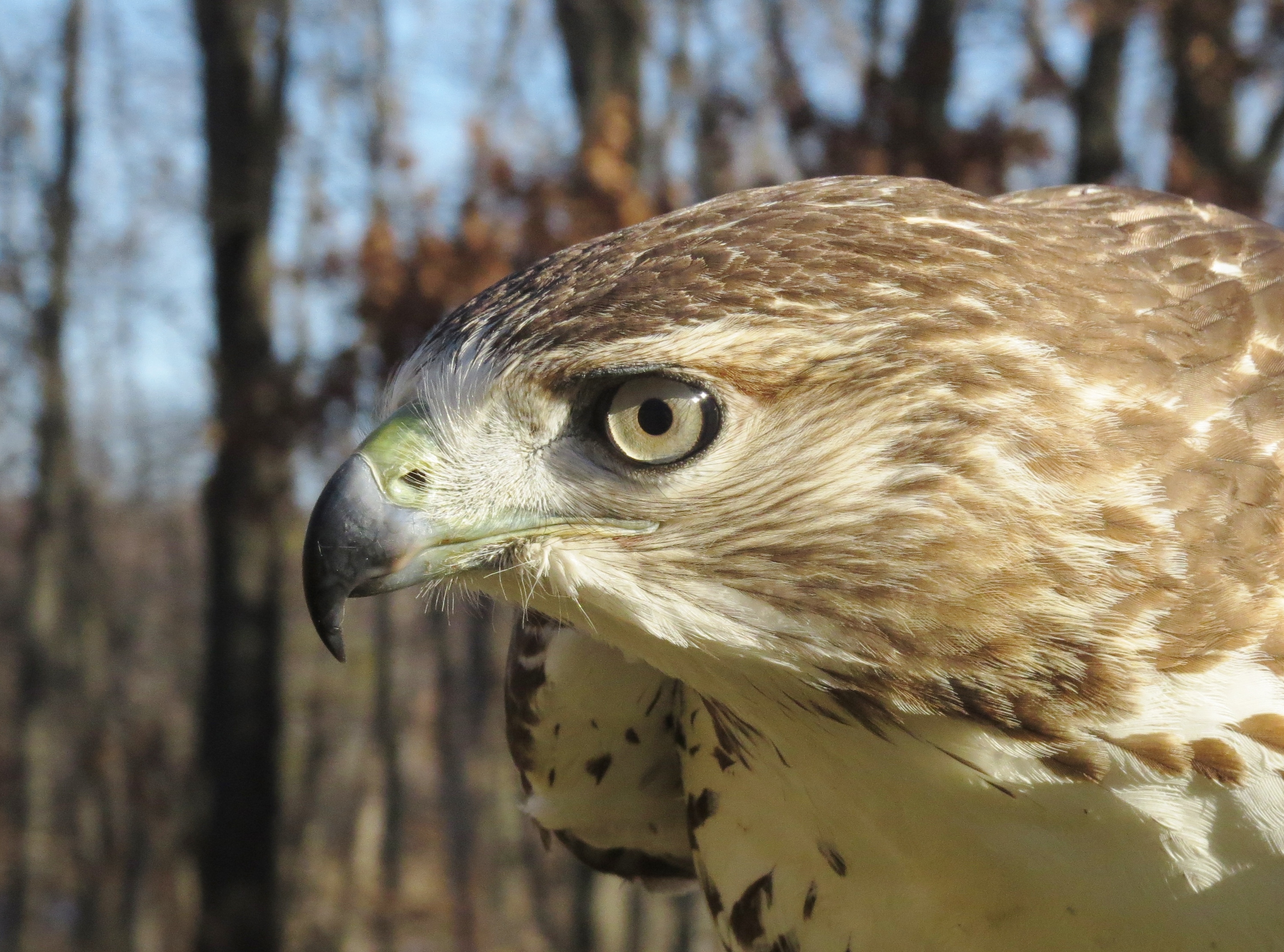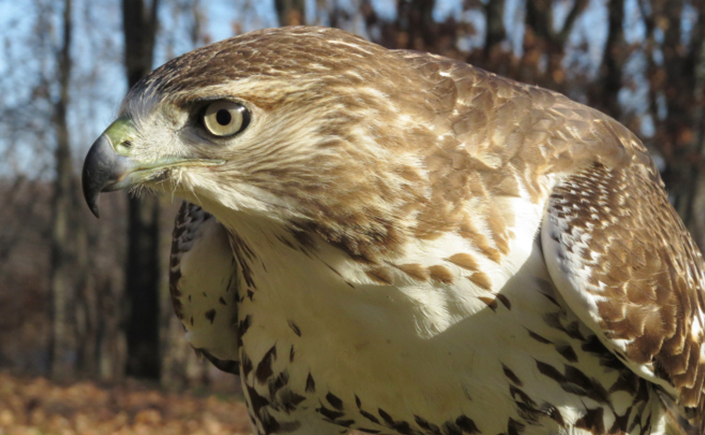WILDER SIDE OF OAKLAND COUNTY
I first become aware of Red-tailed Hawks in rural Connecticut. I was a five or six-year-old nature-hungry kid running barefoot through the meadow that led to a musty barn full of magical things, and then it was on to my favorite forbidden destination: “grandma’s shack”. Red-tails soared above the meadow and I fell in love with their sharp cry. My dad told me that the neighbors called them, chicken hawks. He liked them; so did I. I vaguely remember the horror of seeing some hanging dead on fences. Those are my first recollections of any bird of prey. But the history of birds of prey, and the way humans interacted with them go back thousands of years to the sport of falconry.

Falconry is the sport of using raptors to hunt wild quarry in natural habitat by means of a trained bird of prey. Sometimes the bird of prey would be a falcon. Sometimes an eagle or hawk. In the far distant past however, falconry was not used as a sport or as a pastime, but mainly as a means to catch food for the family. Regulated falconry flourishes today, and the bird of choice for many is the Red-tailed Hawk. Bonding with the hawk is a necessity, and once accomplished the pair shares mutual attraction and loyalty.
The Red–tailed Hawk is found across North America and without a doubt is the most visible hawk of Oakland County. An adult Red-tail is easily identified by its rusty red tail feathers, soaring behavior, and piercing call. Spring is courtship and nesting season. The Cornell Lab of Ornithology describes their dramatic courtship ritual: “Courting Red-tailed Hawks put on a display in which they soar in wide circles at a great height. The males dive steeply, then shoot up again at an angle nearly as steep. After several of these swoops he approaches the female from above, extends his legs, and touches her briefly. Sometimes the pair grab onto one another, clasp talons, and plummet in spirals toward the ground before pulling away.”
Their nests are large structures made of sticks and lined with dry vegetation and fresh foliage and are usually located near the crowns of trees. We have numerous Red-tail nests in the county, but they can be hard to spot. Red-tails are not, however, hard to hear. Just look up in the sky on a bright sunny day when a sudden raspy scream that lasts a few seconds draws your attention. Red-tails vocalize in flight and when defending territory and their young. You may know the call already. Movie producers use it as background sound in westerns, and advertisers sometimes misuse that red tail “scream” to add ear-catching drama to a commercial that has nothing to do with hawks. That was the case in a recent Volkswagen commercial. The raptor snatching a fish from the river in the critical scene is a Bald Eagle, however, the vocalization synced to the action belongs to a Red-tailed Hawk.
The easiest way to see a Red-tailed Hawk takes the least effort. Hop in your car and go for a drive. You need not search along rural roadways to see this beautiful hawk, but when in rural areas, look for them perched on leafless oaks overlooking a freshly tilled feed. Solitary trees are perfect perches to scan a field for rodents. Busy highways and lesser byways of our county, including heavily traveled thoroughfares such as I-75 and M-59 are also prime habitat hunting grounds. The ”highway patrol” Red-tailed Hawks perch on roadside billboards, outstretched roadside tree limbs, large exit signs, telephone poles and on occasion, street light support posts.
The Red-tail has extremely keen eyesight and these roadside perches provide excellent vantage points to watch the ground for squirrels, rabbits, mice, voles and once it warms, snakes. Fox squirrels are an exceptionally easy target in suburban neighborhoods where they gather in numbers to scrounge near bird feeders to clean up winter spillage. The Hawk swoops fast and low, and before the squirrel is even aware of any danger the powerful talons hit, and the kill is made. The squirrel is often back to the nest or consumed on the safety of tree limbs, but sometimes it occurs on the ground as in these images from Oakland County.

Photo courtesy of Barrie Lynn Wood
Hawks in urbanized areas are well accustomed to the flow of traffic and noise of vehicles, but if a driver pulls to the side for a closer look they fly off. On rare occasions, fast flying prey pursuit and swooping low, ends poorly for the hawk as was the case in Milford, Massachusetts in late February when a Red-tailed Hawk winged in front of a car and ended up trapped in the grill. This hawk extraction video is courtesy of the Milford Massachusetts Police.

Spring has arrived and the roads will soon be busy with holiday travelers, spring break celebrants, and spontaneous road trips. Watch the billboards on your journeys. Billboards are now more than the nationwide movie-set hiding places for police officers that run radar; they remain the perfect perches for our magnificent Red-tailed Hawks to wait for meaty meals on the move. Watch your speed, watch for hawks, and make your road trip a “road raptor patrol” for the children in your car. See who spots the first hawk. It won’t take long, for whether your journey is in an urban area, on the “Wilder Side of Oakland County” or anywhere else in our country, one fact remains the same; the sky and billboards belong to the Red-Tailed Hawk.

Jonathan Schechter is the Nature Education Writer for Oakland County Government and blogs weekly about nature’s way, trails, and wildlife on the Wilder Side of Oakland County.
For the latest county news and events, visit our website and follow along with us using #OaklandCounty on our Facebook, Twitter, Instagram, and LinkedIn pages.










[…] turtle, painted turtle, snapping turtle, sandhill crane, great horned owl, screech-owl, barred owl, red-tailed hawk, Cooper’s hawk, turkey, turkey vulture, tree swallow, eastern bluebird, muskrat, beaver, […]
How to I find a falcontry group or individual? My class is reading books with falcontry and I thought they would like to see it in action.
Hi Denise, thanks for your question. To learn more about falconry groups, education, and conservation, visit http://www.michiganhawkingclub.com.
[…] including bullfrogs, milk snakes, raccoons, opossums, snapping turtles, great blue herons, crows, hawks, squirrels, house cats, mink, coyotes, foxes, skunks and even shrews. The eastern garter snake, […]
[…] from Green Frogs, perhaps forgetting their breeding season is long over, and the shrill cry of a Red-Tailed Hawk that took flight from a tree limb reaching over the […]
[…] when pausing to feast during their shopping frenzy, or to watch a human intruder, gives Red-tailed Hawks and the occasional red fox a chance for a meaty treat. That too is nature’s […]
[…] a muskrat will take a risk and scurry across new ice making them extremely vulnerable to Red-tailed hawks and other predators on the wilder side of Oakland […]
[…] finches, owls and hawks. Turkeys move into woodlands with abundant acorns and other fallen nuts. Red-tailed Hawks wait for rabbits or squirrels to pass by, while Cooper’s Hawks often perch near a bird feeder to […]
[…] sunny day can be a magical place. Red squirrels leap from low branches and tunnel under snow. Red-tailed hawks perch on tree limbs above frozen marshes, perhaps waiting for the tempting movement of rabbits. […]
[…] our hike neared its end, I watched a lone red-tailed hawk soar high overhead as my trail companion stopped to hug a large white oak tree that is over two […]
[…] the Southeastern United States. Many species of wildlife look at opossums as a delicacy, including red-tailed hawks, great horned owls, coyotes, and red fox. In human inhabited areas, opossums often meet their […]
[…] route that house injured or orphaned species, guaranteeing the sighting of a white-tailed deer, a red-tailed hawk and a great horned owl. These injured or orphaned creatures cannot be released to the wilds and now […]
[…] but rabbits have a long list of local lurking predators including Barred Owls, Great Horned Owls, Red-tailed Hawks, coyotes, red fox, gray fox, weasels, mink, feral and domestic cats, and dogs. Baby rabbits in […]
[…] even with their wariness and gymnast-like arboreal habits. Many fall prey to predators, with the Red-Tailed Hawk posing perhaps the greatest threat. Although gray squirrels can scamper along the ground at 10-15 […]
[…] herons, American egrets, green frogs, bullfrogs, northern water snakes, garter snakes, skunks, hawks, gulls, raccoons, foxes, coyotes, mink, otters, turtles, and humans that savor the flavor of frog […]
I particularly enjoyed this Blog! Thank you for revisiting! It’s near and dear to my heart!!!
Thank you Julie! I had fun writing it, and especially loved working with the red-tailed that worked with a falconer. I’m glad we ran it again.
I’m getting regular juvenile hawks in my backyard. They prey on the many pigeons that feed under my bird feeder and at another neighbors. Although it’s Nature, it’s still upsetting to watch them pick apart those defenseless pests
Hi Sandy. Just saw your comments from last week. Yes, that is nature’s way but i\I wonder if perhaps you are seeing Cooper’s Hawks keeping the check on the pigeons. They are avid hunters of birds that gather at feeders. (But it could be red-tailed hawks) But the bottom line is if there was no feeder there, birds would not be gathering in large numbers and the hawks would not be hunting those ‘defenseless pests’ Thanks for sharing!